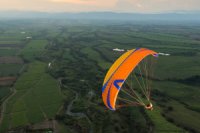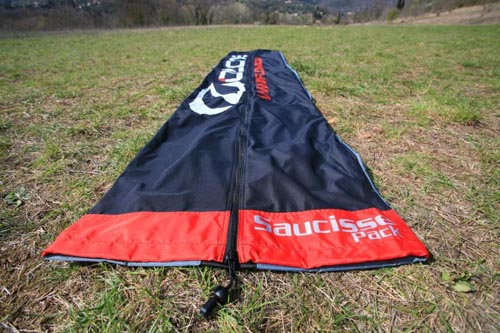The new Ozone Delta 4 offers the largest performance gain yet seen with the Ozone Delta model range, whilst retaining the comfort and ease of use that has made this series the best-selling sport class wing of all time.
The Delta 4 has 2-Liner technology in the wing tips significantly reduces drag while improving spanwise lift distribution.
A new lower-drag profile developed from the Mantra series with smaller openings and higher efficiency.
Performance Testing
True Performance
New ACR System
Safety
Thanks to the Ozone Shark Nose profile, the wing is resistant to spin & stall and can be flown safely at low speed making top landings, or landings in tight spots, simple for a wing of this class.
Tuned for Joy
The Pilot
<!--td {border: 1px solid #ccc;}br {mso-data-placement:same-cell;}-->
Delta 4 Specifications XS S MS ML L XL Number of cells 66 66 66 66 66 66 Projected area (m2) 16.4 18.4 19.6 20.7 21.8 23.4 Flat Area (m^2) 19.3 21.7 23.1 24.4 25.7 27.6 Projected Span (m) 8.52 9.04 9.33 9.59 9.84 10.19 Flat Span (m) 10.81 11.46 11.83 12.16 12.47 12.92 Projected Aspect Ratio 4.4 4.4 4.4 4.4 4.4 4.4 Flat Aspect Ratio 6.05 6.05 6.05 6.05 6.05 6.05 Root Chord (m) 2.25 2.38 2.46 2.53 2.6 2.69 Glider Weight (kg) 4.45 4.79 5.07 5.26 5.45 5.76 Certified Weight Range (kg) 58-70 65-85 75-95 85-105 95-115 110-130 Recommend Flying Weight (kg) 60-70 70-84 82-94 90-104 100-114 112-128 EN / LTF C C
DESIGNER'S NOTES by Luc Armant
The Delta Series has never seen such a big leap forward in performance.
A new line-plan with a two-liner structure on the outer span has significantly reduced line drag.
The spanwise lift distribution in accelerated flight has been improved thanks to the new wingtip rigging and wing-tip riser system, which reduces induced drag.
The new airfoil, which has smaller openings and the Ozone G-string, also contributes to the performance increase.
During side by side glide tests with the D3, at maximum speed of the D3, the D4 has a massive advantage in terms of sink rate: meaning that it glides significantly better at max speed.
The Delta 4 max speed is 3km/h faster than the Delta 3 At trim speed there is 0.2 points improvement in glide ratio for the D4. The Delta 4 climb efficiency is significantly better. We believe that these factors make the D4 the highest performance cross country wing in the category, even while having very tame behaviour and easy handling.
Easy and fast gliding in turbulent air – Full-chord control handles Solidity in accelerated flight is greatly improved thanks to a new airfoil and new internal structure.
The pilot is connected intuitively to the wing thanks to dedicated full-chord handles, inherited from the Mantra M7 and the Zeno series.
The pilot need only take the comfortable handles and apply some pressure on it while pushing the bar. When the lift decreases due to a reduction of the angle of attack in turbulence, the risers control makes the corrective input almost automatic, keeping a safe angle of attack without interfering with the profile camber, thanks to the direct connection to the B risers. The Full-chord handles allow you to glide easily in active air during speedy XC transitions.
The handle pressure is fine-tuned to allow the pilot to control his wing for long hours of cruising in turbulent air, without fatigue.
Intuitive and efficient AoA control, an improved airfoil design, and a highly balanced structure, makes the Delta 4 an impressive glide machine in turbulent air.
G-String First introduced in the Rush 5, the G-string delivers most of the benefits of increased cell count, without the downsides (stitching precision loss, added weight, and cost). On speed bar, it has an anti-vibration effect and it helps to keep the leading edge shape, which increases performance. It’s also beneficial to wing reopening behaviour after collapse.
Easy all-round behaviour outside of the flying box The behaviour after collapses have been improved by keeping the aspect ratio relatively low and by improving the structure and the lines architecture. The Delta4 shows very little tendency to cravat after collapses. It always reopens immediately from frontal collapse. It rotates very little after asymmetrical collapses. It does not show tendency for shocking reinflation.
The wing is very resistant to stall and can reach safely very low speed. Span cohesion at very low speed is such that top landing has never been so easy for such a level of performance.
Precision handling with efficient thermaling A lot of work has been done to fine tune the handling and improve the precision through the brake, while keeping excellent climbing efficiency.
The Delta4 chord structure has very little deformations through brake which improve the wing cohesion in a turbulent thermal. The whole internal structure response has been fine tuned in order to keep reasonable brake pressure and a nice linearity of the wing’s response.
In order to associate precision and efficiency in thermaling, we developed a new brake line architecture including 28 upper line attachments associated with 28 V-tabs. The trailing edge keeps a very good tension through the whole brake range which allow very little loss in the brake fan in between the attachment points.
Roll and yaw response to brake input has been tuned for joy, pleasure and efficiency.
Big ears Despite the two-liner wing tip structure, conventional big ears are still easy. Inducing and maintaining big ears requires more pressure and we have put a dedicated sheathed line in order to maintain a good comfort while maintaining big ears. Thanks to these extra lines, you can maintain bigger ears which allow more efficient descent. On the Delta4, the big ears have a high propensity to reopen by themselves. We have also improved the line architecture in order to avoid these irritating small cravats that other wings often do after big ears.
Material and weight Despite the use of strong, durable and well-known material on the skin panels, we were able to reduce the Delta4’s weight by 220g by optimizing the inner structure. The inner panels have more than 2000 carefully placed holes, made possible by the use of a high precision laser cutting technology, which reduced the weight by 35%. You won’t carry much unnecessary material.





